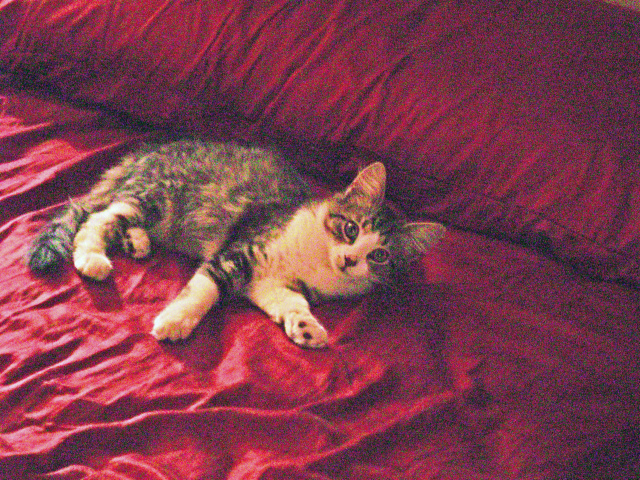QuestionMy wife and I have three cats in the house. One is an inside/outside female who seems to get along with everyone. One is a very old female, going on 13 years. The last is a relatively young one, not sure on the age, he was a stray. Probably about 3 or 4.
My question has to do with the young and the new. Since we brought the young male into the house, about 3 years ago, he has constantly bullied the old female. He seems to enjoy the "pounce and run" while she sleeps technique. At one point, she seemed so fearful of him that she wouldn't leave the bedroom. She has always been on the cranky side, but it's gotten worse since his arrival.
Now she will at least leave the bedroom and sometimes wander through the house, but always on the lookout for him. As soon as she sees him, she runs for cover hissing and growling.
My question is how do I effectively punish the young male for bullying the old female? When we see it happen, we instantly grab him and stick him in a pet carrier we have for large dogs. We keep food/water and a litter box in there for him. We normally keep him in there anywhere between 15 minutes to an hour. But it doesn't really seem to do any good.
What else can we do?
AnswerCorey,
Punishing your cat isn't going to be effective or useful. Cats do not learn well when they're punished for inappropriate or unacceptable behavior. It's important to consider that to punish or to discipline are very different actions. The dictionary definition of the word punish is as follows: to impose a penalty on for a fault, offense, or violation, to inflict a penalty for the commission of (an offense) in retribution or retaliation, or to deal with roughly or harshly, to inflict injury on. Cats don't understand punishment whether it's physical or psychological. Punishing a cat can have detrimental effects with regards to behavior and I've met cats who were punished and their behavior actually worsened as a result of the stress they were under.
At 13 years of age your older cat's roughly 68 in human years, your younger cat's around 28. There's a conflict happening because these cats both have different needs, your 68 year old wants to live a quiet, routine life where she can live peacefully and quietly without being disturbed. Your 28 year old bachelor wants to party and have fun, kind of like bringing some unruly frat member into a retirement home - the combination isn't going to work without help. It's important to recognize and respect the needs of your older cat and make an effort to provide her with a safe, quiet place she can go without worrying about being bothered by the younger cat. One way to accomplish this would be to install a cat door on one of the interior doors and put the magnetic key on the older cat's collar. Sometimes time outs can be effective for cats, but in this case they might be making things worse.
The Merriam Webster online dictionary defines discipline as teaching, learning, training that corrects, molds, or perfects the mental faculties or moral character, control gained by enforcing obedience or order, orderly or prescribed conduct or pattern of behavior, self control, a rule or system of rules governing conduct or activity. Cats are incredibly smart and easily trainable once we find out what motivates an individual cat. Some cats have a favorite type of affection or attention that they're willing to work for, others have a toy that's special to them and will motivate them to learn. Most often when it comes to training cats and teaching them boundaries I've found that most cats respond well to a favorite food or. When teaching your kitty new behaviors it's important to be patient, persistent and most of all keep the sessions short. Cats have a short attention span so while they're very intelligent and easily trainable they lose interest if the training sessions are too long. I work with my cats for roughly 5-10 minutes at a time once or twice daily. Training a cat can help channel his extra energy with a very positive end result.
I think it's important to consider all kinds of different options in terms of learning how to work with your younger kitty and helping him to understand what constitutes acceptable behavior and what specific things won't be tolerated within your household. I think that it might be beneficial to consider finding a holistic veterinarian to help the cats work through their individual problems without using a pharmaceutical approach. In my experience cats tend to respond very well to alternative therapies and holistic vets are trained in conventional medicine as well as one or more alternative therapies which can include homeopathy, acupuncture, massage or Reiki to name a few treatment options.
Using different disciplinary tools and training techniques will most likely have more positive results than punishing a cat for inappropriate behavior. Taking time to play with your younger cat for a minimum of an hour (preferably more if at all possible) each day using interactive toys like kitty teases and kitten mittens will help your kitty burn off his excess energy in a constructive way so that he doesn't have to torture the older lady in the household as a means of entertainment. If you have a screened in porch, purpose built cat run or your cats are trained to accept a harness and walk on a leash you can allow the younger kitty to have safe access to the outdoors. The sounds, smells and entertainment value are useful when it comes to tiring out a bouncy young cat bent on expending his excess energy and frustrations any way that he can.
I would also suggest that you consider using humane disciplinary tools, training and positive reinforcement to help the cats understand which behaviors will or won't be tolerated within your household. There are a few humane disciplinary tools that I use fairly frequently when I need them - a squirt bottle filled with water, a can of compressed air, shaker cans or air horns can all change bad behavior abruptly.
It's very important that you don't recycle a spray bottle from household cleaning products or other chemicals, I purchase mine from the dollar store and they work well. Most cats aren't fussy about being squirted with water, they take great pride in themselves so they prefer not to be squirted and be forced to dry their fur and smooth it back into place, though there are exceptions - some cats make a game out of being squirted.
With cats who aren't persuaded to change bad behavior after being squirted with water you can use cans of compressed air, I use the cans sold for cleaning keyboards and electronic equipment. It's extremely important that nobody ever aims the can directly at the cat, pulls the trigger at close range or tilts the can on an angle when in use because these products contain chemicals that can cause frost bite. If you aim the compressed air in the cat's general direction and pull the trigger it won't likely take long for him to get the message - the air makes a hissing sound on it's way out of the can that cats completely understand.
Shaker cans are simply a can or plastic container with a small amount of dried beans, rice, pennies or lentils inside. You secure the lid onto the container and you have a shaker can. You can use your shaker can to discourage bad behavior and as the name implies you have to shake it.
Air horns sold in the form of a small can will instantly startle most cats, they're loud though so if you live close to your neighbors or you're in an apartment I don't recommend them. I rarely use this tool because it's so loud and cats have extremely sensitive hearing, I usually tell a cat behaving badly "NO!" in a sharp voice or clap my hands because these two options are effective without hurting anyone's ears.
It's important that you train your cats and teach them what behaviors are acceptable within your household so that they don't become prisoners of their own misbehavior. Well trained cats make good pets. Getting frustrated, angry or anxious when your cat misbehaves isn't going to fix anything - stay calm, be gentle and assertive. If you don't catch the cat while he's doing something unacceptable you can't discipline him, he won't understand what he's done wrong. If one of your cats happen to misbehave and you're right there you can use humane disciplinary tools including items that I've mentioned or your own voice. Never, ever strike a cat, that's abuse and it's not an effective way to teach them anything other than to be fearful of their human caregivers.
Cats are very smart, they're trainable and they learn quickly with the right motivation - my own cats know several "doggy" obedience commands including sit, beg, sit pretty, stay, down and roll over. In order to teach your cat acceptable behaviors or tricks you have to motivate him. Using humane disciplinary tools when he's behaving badly will communicate your displeasure. I've found that when teaching obedience commands to cats it's important to do so in a quiet, distraction free environment and have a favorite toy or treat on hand. You know your cat better than anyone else does, find out what he's motivated by. What will your cats do just about anything for? Once you know what motivates your cats you can begin training. Teaching cats obedience is pretty much done the same way as it's done with dogs, but most cats are smart enough not to do anything that's humiliating or is undignified. Providing your cats with a repertoire of appropriate behaviors to choose from will hopefully mean that he's a happy, healthy and well adjusted pet for many years to come.
Providing distractions like bird feeders within your yard filled with bird seed meant to attract small song birds and making sure it's within view of each cat's favorite window ledge can help to ease boredom. If you live in an apartment you can pick up the Cat Sitter DVD series, these are videos designed for cats which contain some great shots of fish, mice, birds and other small prey animals. These movies are designed to be shown when the cats are home alone without distractions, the first two seem to be more popular than the third video in the series which shows tropical and marine fish swimming about in their aquariums. If you do want to show the Cat Sitter DVDs then you'll want to move any sentimental items, pictures and figurines on top of or near the television to avoid accidents. Cats often want to bat at the screen and attempt to find their prey that just walked off of one side of the tv screen. A comfy chair or large sturdy cat tree with ledges for the cats to hang out on will enhance their enjoyment of the videos, they can climb, rest and watch tv designed specifically for their viewing pleasure.
The younger cat in your home doesn't sound like he's trying to be a bad cat. At this stage he's got loads of energy, no way to burn it off and he's probably bored senseless and as we all know boredom doesn't always bring out the best in people. I suspect that your young man is looking for a playmate and trying to convince the only other cat in your household to play with him. I don't dispute the fact that this kitty's not exactly able to understand the advantage of being gentle or subtle about his invitations to the little old lady. When cats and other animals aren't burning off their excess energy in some way that can lead to them becoming frustrated, bored, and/or agitated. Sometimes these negative states of mind can cause less than appropriate responses to their human caregivers or other pets in the household. If you want a good way to help minimize your frat boy's behavior there are a few options at your disposal.
You may want to consider saving a life by adopting from your local shelter. Depending on the size of your home and other issues unique to your home situation it's important to be completely honest with everyone in the family about the amount of time you have to devote to one or more new cats, the cost of veterinary care for a new adoptee and the space within your home. If you know exactly what you want prior to checking out the animals available for adoption at your local shelter or rescue group then you won't be likely to make an impulsive decision that you might regret later. You could adopt a single young cat, say a spayed/neutered kitten 6-8 months old or younger. There is an appropriate and humane way to introduce a new cat or kitten into your household, in fact it can be the difference between a chaotic, stressful and overall unpleasant life with your cats and the ability to maintain peace within the household so that everyone's happy.
If you're in the market to adopt a new cat then I'd suggest adopting a young cat or kitten. The new kitty has to be energetic, playful and it's helpful to find out if s/he's okay with other animals including cats. You can't exactly bring your resident cats to the shelter to try a meet and greet to see how things go, cats don't do well with stuff like that, it's a stressful, unfamiliar environment and stress doesn't generally bring out the best in any cat. Once you're sure that your resident cats and the new family member(s) are curious without showing aggressive behavior you can try your first face to face meeting, but you should be prepared to usher the new kitty back into his/her room if things start getting ugly. It's very important that nobody gushes over the new felines in the house, it can create serious jealousy and aggression because your resident cats were there first and they deserve to be treated with the respect they deserve - once things calm down and everything's back to normal you can pay attention to all of the cats equally.
If one or both of your cats hasn't been spayed/neutered yet it's important to do so before thinking about adopting any new feline family members. After all you wouldn't want to contribute to the already serious pet population explosion by ending up with an accidental litter of kittens. Spay/neuter surgery also helps prevent many common behavioral issues, some serious medical conditions and the surgery minimizes the risk of certain medical issues.
New cat introductions have to be done very gradually over the space of 2-4 weeks although some cats will take longer to become comfortable with other pets. It just depends on how territorial each cat is. As a rule cats aren't fond of sudden/unexpected changes in their territory which is why things have to be done gradually at a pace the cats are all comfortable with. If you do decide to adopt one or more cats from your local shelter they should be isolated in a room of their own with all of the usual kitty necessities and creature comforts for about 2-4 weeks, some cats react very well to changes in their environment and things may move more quickly than anticipated, other cats will take longer to accept changes in their territory and completely simmer down. It's best to take your time with new cat introductions, be patient - it'll happen. Things tend to be much less complicated and difficult if all of the cats involved are spayed/neutered. The reason for taking the time to gradually get your resident cats comfortable with a newly adopted cat or kitten is to allow them to work things out for themselves. Feeding the cats on either side of a closed door is a great way to speed things along because it helps cats to associate each other's presence and scent with something positive - food.
I usually introduce newcomers to my household by reassuring my resident cats so that they understand that nothing's changed, some cats really need to have extra attention and be comforted when a new kitty is introduced to the household. Playing with a favorite toy, giving special treats and attention are other great ways of creating positive associations between resident and adoptive cats so they're more likely to live together in relative harmony, even if there are some wrinkles needing to be ironed out in the beginning with respect to how everyone fits into the household's feline social hierarchy. There will be some degree of posturing, maybe some hissing, laying the ears back and exchanging dirty looks or swats, provided that the cats aren't hurting each other or acting excessively forceful then it's best to watch how things unfold and intervene only if it becomes necessary to do so. If you do need to break up a nasty discussion be sure that you don't place hands or any other body parts in between the cats to avoid being bitten or scratches accidentally. Sometimes cats can be so full of adrenaline and agitated that they'll strike out at whoever happens to be in the way. Cat bites tend to get infected if you don't seek medical attention, so save yourself the hassle, use a broom or other inanimate object to guide the new cat into a room by himself so that you can close the door and allow him to cool off.
If there's a small gap under the door in the room where the new cat's being housed you can watch for signs of acceptance like seeing the cats play with each other under the door and a marked decrease in tense, aggressive behavior when they smell or hear each other. Isolating a new cat in your household has the added benefit of protecting all of your cats from contagious viral or bacterial infections and gives you time to have your vet examine the new cat, once everyone's comfortable with each other and has a clean bill of health then you can begin face to face introductions - if you see aggression you'll need to return to the previous problem free step until tensions cool.
If you do choose to adopt a playmate for your feline frat boy and you find that your resident cats or the new arrival seem agitated, traumatized, fearful or anxious you can use a homeopathic remedy called Bach's Rescue Remedy which is a blend of flower essences that's designed to calm and reassure. This is a remedy I've used many times over the years and it's often quite effective. Cats who are adopted from a shelter need to have some time to de-stress prior to handling them too much. Institutional life within a shelter is especially tough for cats because things are fast paced, crowded, impersonal and noisy. Cats like routine, they thrive on it, they also enjoy having peace and quiet, these are pretty much lacking in most shelters. So many cats and dogs are in an average shelter at any given time, most often cats/dogs and other animals haven't been sterilized, tons of hormones are at work and that increases the likelihood of aggression and territorial behavior. Another factor that bears mentioning is the fact that shelter animals spend days being passed over many times before they're adopted which I believe takes a toll on them as well.

 Female Cat changes behavior
Question
Patches
I have four older cats, a dog and now
Female Cat changes behavior
Question
Patches
I have four older cats, a dog and now
 What breed is Jerome the Cat
Question
Jerome the Cat
Hi Karen.
Last summer on my da
What breed is Jerome the Cat
Question
Jerome the Cat
Hi Karen.
Last summer on my da
 Additional info about the possbile norwegian
Question
Edmund at 4 months
I forgot to mention. Edmund
Additional info about the possbile norwegian
Question
Edmund at 4 months
I forgot to mention. Edmund
 Identifying kittys breed
Question
Moggie
Hi I have a gorgeous ginger moggie I wa
Identifying kittys breed
Question
Moggie
Hi I have a gorgeous ginger moggie I wa
 The breed of my 5 1/2 month old kitten
Question
Edmund 5 1/2 months ol
Hi, my husband and I re
The breed of my 5 1/2 month old kitten
Question
Edmund 5 1/2 months ol
Hi, my husband and I re